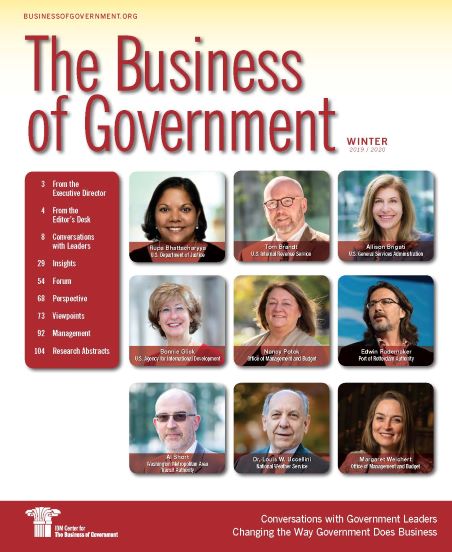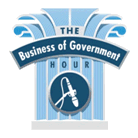
Providing Mission-Support Services Across Government

The U.S. General Services Administration (GSA) is working with federal agencies on multiple fronts to save taxpayer dollars and improve the efficiency and effectiveness of the federal government. This unique mission support role ties back to GSA’s founding in 1949 when President Truman sought to create one agency to help the federal government avoid senseless duplication, excess cost, and confusion in handling supplies and providing space. Today, GSA fulfills this mission, pursuing a wide range of programs that support partner federal agencies with their real property, procurement, information technology, and shared service’s needs.
What are GSA’s strategic priorities? How is it providing mission support services to federal agencies? Allison Brigati, deputy administrator at GSA, joined me on The Business of Government Hour to share her insights on these topics and more. The following is brief excerpt of our discussion.
We have four priorities. Our first priority is to save taxpayer money through better management of federal real estate. The second priority is to establish GSA as the premiere provider of efficient and effective acquisition solutions across the federal government. Our third priority involves improving the way federal agencies buy, build, and use technology. Lastly, we want to design and deliver expanded shared services within GSA, and across the federal government to improve performance and save taxpayer money.
GSA’s mission is to deliver value and savings in real estate acquisition, technology, and other mission support services across government. In July 2019, GSA celebrated our 70th anniversary. As we reflected on the agency’s history, it is amazing to see how stable our mission has been over the years. President Truman established the agency in 1949 wanting to create an agency to help the government avoid senseless duplication, excess cost, and confusion in handling supplies and providing space. While the mission has been quite steady, we are always evolving in not just how we deliver on this critical mission support role for the government, but also in what we deliver.
An example of how we have evolved over the last few years, we have been keenly focused—as a result of positive policy and industry shifts—on customer experience and data driven policy and decision making. If not the first, we were one of the first agencies to create the roles of the chief customer officer and the chief data officer. As part of our evolution, the delivery of technology services has become a major line of business for GSA. In addition, we play significant roles in promoting management best practices and efficient government operations through the development of governmentwide policies. That function resides in Office of Government-wide Policy, which I led when I first came to GSA.
GSA’s scale of operation is pretty significant. We have more than 11,000 employees, $24 billion in annual revenues, $43 billion in assets, including property, vehicles, and office equipment. A gross annual budget authority of $9.7 billion and an additional $17.8 billion in obligations, supporting approximately $68 building in annual contracts. For context, our annual revenue puts us roughly in the top quarter of Fortune 500 companies, so we’re just a few spots below a very well-known coffee company. On the real estate side, with more than 368 million rentable square feet in over 8,700 active assets, we administer one of the largest and most diversified real estate portfolios in the world.
In terms of the policy side, most significantly I’m sure you’ve heard of the Federal Acquisition Regulation (FAR). The FAR set the rules that govern the more than $500 billion in annual procurement spend by the federal government. We manage the FAR in coordination with NASA, Department of Defense (DoD), and the Office of Management and Budget (OMB).
I am the chief operating officer for the agency. I manage the day-to-day operations. While I do get engaged in our core business lines, my day to day focus is on managing the internal operations of GSA. The C-Suite reports up through me, which include IT, finance, human resources, as well as the Office of Administrative Services, basically a mini-GSA within GSA, and Office of Customer Experience. Managing the CXOs account for roughly 2,000 of our 11,000 employees and an annual budget of $700 million. As deputy administrator, I also manage agencywide initiatives. One of those initiatives is the Technology Modernization Fund Project Management Office (TMF PMO), which was established by the Modernizing Government Technology Act. The other initiative involves working on the proposed merger of the Office Personnel Management (OPM) and GSA. I also managed the standup of New Pay initiative: the governmentwide initiative to establish GSA as the single civilian payroll provider. Recently, this initiative was transferred over to the GSA Chief of Staff’s office. Finally, managing GSA’s coordination effort during presidential transition also falls under the deputy administrator’s portfolio.
I love this initiative. I’m excited to be a part of it. It was authorized by the Modernizing Government Technology Act of 2017. Since that time, the fund has received $100 million in FY 2018 and another $25 million in FY 2019. I oversee the TMF’s Project Management Office along with its executive director and the federal CIO, who chairs the TMF Board. The board is made up of IT and acquisition experts across government. The process borrows from the TV show Shark Tank. Agencies come pitch different ideas to the board. The board does a very rigorous assessment process with key players involved in the proposed project. The fund is designed to provide resources for the IT modernization project that never seem to receive the proper funding. The TMF is a great way for these projects to get funding. It is important to underscore these are not grants, but loans that are expected to be paid back with savings from whatever it is that they are modernizing.
The funds are also dispersed in tranches. If an agency requests $15 million, the board will allocate a set amount to, say, run a pilot or provide upfront monies. However, the next tranche of money isn’t provided until progress is reported and results shown. As of this discussion, we have awarded seven projects totaling $89 million. It is important to note that in July, the TMF PMO received three payments totaling about $1.1 million. This is important for two reasons: first, getting repaid may assuage some of the initial doubt about that aspect of the TMF concept, and second, that repaid money can be used to support another TMF project.
GSA has two projects under TMF. We have the application modernization project that is helping us transition from legacy technologies to open source technologies. The other GSA TMF project was the New Pay project. This initiative is essential to GSA’s goal of making back office operations more efficient. This is a great example of a common repeatable transaction service that, as a government, we can and should do in a shared, centralized way. New Pay is trying to get the federal government to streamline even further, achieving a single payroll provider for the civilian side. So, right now, those four current payroll providers are stuck with some pretty old, costly systems, and they need to be repaired or replaced. Maybe not today, maybe not tomorrow, but very soon. We believe that through this migration to a single provider, we can realize some significant economies of scale. We can modernize to a software as a service model, which puts the risk and the cost off onto whoever is providing that software as a service and then improve the functionality and user experience of the payroll technology.
It depends on context. Leadership in the military looks very different from leadership at a tech startup. For me, leadership starts with building a sense of trust. I am very much a team player. I have always viewed my role as leading from within the group as opposed to running ahead and asking everyone to follow me. I want my team to feel like we are in it together. I try to create an environment that is a little more casual, friendly. I want people to feel safe to disagree with me and freely share their opinions. I may not listen, but I want them to tell me what they think. I have noticed that—one of my pet peeves—people in leadership positions that go around and talk about “I did this and I did that.” It drives me crazy because we don’t do anything by ourselves. In government, leaders must understand that it is a group effort. I try to make sure that my team knows that I recognize everything that they have done to get us across the finish line and that they know I appreciate all that they do.
te the further adoption and integration of ERM into and throughout the entire federal government.





